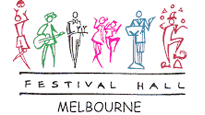Festival Hall (Melbourne)
| The House of Stoush | |
 | |
| Former names |
West Melbourne Stadium Melbourne Stadium The Stadium |
|---|---|
| Location | 300 Dudley St, West Melbourne, Victoria, 3003 |
| Coordinates | 37°48′40″S 144°56′47″E / 37.81111°S 144.94639°ECoordinates: 37°48′40″S 144°56′47″E / 37.81111°S 144.94639°E |
| Owner | Stadiums Limited |
| Operator | Arena Management Pty Ltd |
| Capacity |
Seating: 1,741 Standing: 2,600 Concerts: 5,445 |
| Construction | |
| Opened | May 1915 |
| Construction cost | 250,000 pounds |
Festival Hall is a concert and sporting venue located at 300 Dudley Street, West Melbourne, Victoria. It is one of Melbourne's larger concert venues and has hosted a variety of local and international acts over many years.
History
Formerly known as the West Melbourne Stadium (shortened to The Stadium), it was originally built in 1913 by R.L.Baker, the Sydney boxing promoter, opening just in time for the Mehegan-Wells fight of 3 November 1913. In 1915 it came under the control of John Wren[1] (chairman) and Dick Lean (general manager) of Stadiums Limited as a multi-function venue for boxing and pro wrestling. It quickly became known to locals as "the House of Stoush", as over the years it has featured some of the greatest names in Australian boxing including Lionel Rose, Johnny Famechon, Anthony Mundine, Lester Ellis and Barry Michael. Professional wrestling also featured regularly, as did Roller Derby, ballroom dancing, cultural and religious gatherings and the first Indoor Tennis Exhibition featuring John McEnroe. It was used by the Painters and Dockers as a meeting place. During the Great Depression, unemployed men seeking work would gather at Festival Hall to be picked for dock work.
The Stadium was destroyed by fire in 1955 but was rebuilt in time for the 1956 Olympics, where it was used for boxing, basketball and gymnastics events.[2][3]
Dick Lean Jnr (son of the original general manager, Dick Lean) joined Stadiums in 1960 and set about successful promotion of major music acts of all genres from both the UK and US, increasing the use of the venue significantly. The Stadium was renamed Festival Hall in the early 1960s to reflect its increasing use as Melbourne's largest live entertainment venue at the time. Lean booked the Beatles to play Australia in 1964. Lean continued to promote and bring to Australia many of the major headline acts during the 1960s, 1970s and 1980s.[4]
The Living End's Live at Festival Hall was filmed there on 19 May 2006.
On 30 January 2008, Rage Against the Machine performed at the venue in what was only their second headline show outside the United States since their breakup in September 2000.
Festival Hall’s versatile set-up has been used for many events including a weekly conversion into a television studio for the production of The Price is Right for the Seven Network. The venue has also been used for black tie dinners, product launches, conferences, motivation sessions, art exhibitions, large Christmas parties, religious and cultural events, and even as an examination venue for Swinburne University.
Configurations
Festival Hall is used for seated events of up to 4,586 including the main floor or for up to 5,445 if the floor is used for standing, sight lines permitting. The addition of floor-to-ceiling curtains around the main floor and between the side sections allows seating for up to 1,741 people or 2,600 standing on the main floor. The main floor has an area of 1,288 m², providing room for dining for up to 1,000 seated guests plus dance floor, and the stage offers a further 160 m² of elevated space.
See also
References
- ↑ "memorable stadiums - Melbourne Stadium later renamed Festival Hall". Australian Boxing News. Retrieved 2 December 2009.
- ↑ "Festival Hall Live Music Venues Dining and Drink". Only Melbourne. Retrieved 2 December 2009.
- ↑ 1956 Summer Olympics official report. Archived 12 September 2008 at the Wayback Machine. p. 42.
- ↑ http://www.classicbands.com/JohnnyChesterInterview.html


_pictogram.svg.png)